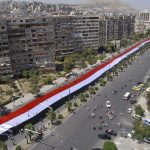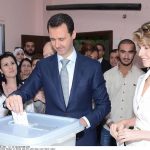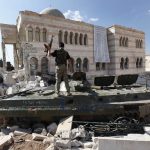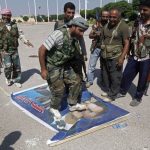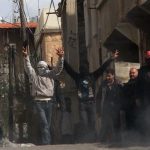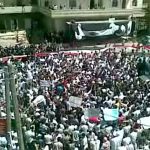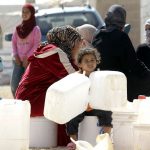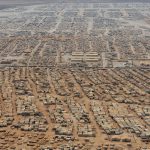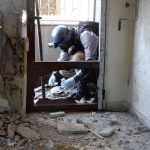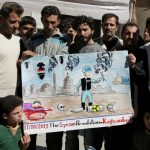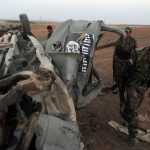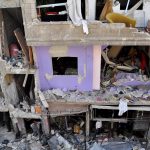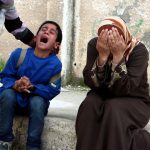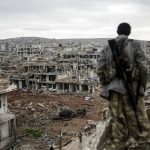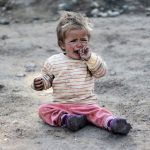A grim anniversary


BY CHRISTOPHER MILLER From Mashable
It began with pro-democracy protests on March 15, 2011, eventually becoming a revolution.
Since, the Syrian uprising has devolved into a brutal and complex war that spawned a global refugee crisis and fueled the rise of the brutal Islamic State (ISIS) group.
Many of those activists who first demonstrated in streets across the country are now disillusioned, or else they have disappeared or been killed.
SEE ALSO: The 5-year-olds who have grown up away from their homes in Syria
In all, the Syrian Center for Policy Research (SCPR) estimates 470,000 Syrians have died and 1.9 million people had been wounded during the war, while life expectancy plummeted from 70 years in 2010 to 55.4 years in 2015.
So today marks a grim anniversary.
Here is a timeline of some of the major events over the course of the conflict, now entering its sixth year.
Gettyimages-462518530
Musa, a 25-year-old Kurdish marksman, stands atop a building as he looks at the destroyed Syrian town of Kobane, also known as Ain al-Arab, on January 30, 2015.IMAGE: BULENT KILIC/AFP/GETTY IMAGES
2011: The uprising
Anti-government activists gesture as they gather on the streets of Daraa, south of the capital Damascus on March 23, 2011.
IMAGE: ANWAR AMRO/AFP/GETTY IMAGES
Deraa, known as “the cradle of the uprising,” was the first city in Syria to revolt against President Bashar al-Assad on March 15, 2011. Assad’s security forces moved in quickly to quash the protests, shooting and killing dozens of demonstrators.
But the violence only fueled more protests, which spread to cities across Syria. Demonstrators called for Assad’s ouster.
A screen grab from footage uploaded to YouTube shows hundreds of anti-regime protesters demonstrating in the southern Syrian city of Daraa on Aug, 19, 2011, as protesters continue piling pressure on President Bashar al-Assad after Western leaders demanded he step down.
IMAGE: AFP/GETTY IMAGES
IMAGE: ASSOCIATED PRESS
The regime continued cracking down on what it called “an armed rebellion” by radical Islamists, and pro-regime demonstrators turned out in the streets of Damascus in support of Assad.
Pro-government demonstrators marched through Damascus carrying a large Syrian flag to show their support for President Bashar al-Assad, June 15, 2011.
IMAGE: ASSOCIATED PRESS
But the U.S., Britain and France condemned the regime’s repressive tactics.
The first refugees began to flee from the violence in Syria and head for neighboring countries.
The situation then spiraled into conflict.
2012: Full-blown war
A Free Syrian Army fighter from the Al-Faruk brigade steps on a portrait of Syrian President Bashar Assad near a Turkish-Syrian border crossing captured by the rebels, Sept. 22, 2012 .
IMAGE: AP PHOTO/HUSSEIN MALLA, FILE
The chaos spiraled into all-out war as Syrian forces stepped up their bombardment of towns controlled by anti-Assad groups.
Moderate rebels of the Free Syrian Army declared to fight government forces in a battle for the capital, Damascus, which they ultimately lost.
A Free Syrian Army soldier stands on a damaged Syrian military tank in front of a damaged mosque, which were destroyed during fighting with government forces, in the Syrian town of Azaz, on the outskirts of Aleppo, Sept. 23, 2012.
IMAGE: AP PHOTO/HUSSEIN MALLA, FILE
They then launched an offensive in the northern city of Aleppo, which was divided between controlled districts in the east and regime-held areas in the west.
The conflict grew more complex by the day, as new armed groups entered the fray. Hezbollah said it sent fighters to back Assad’s forces, and they then went on the offensive.
2013: Chemical weapons
Syrian anti-government protestors hold a poster depicting a inspector from the Organisation for the Prohibition of Chemical Weapons (OPCW) during a demonstration to call for an international action against the Damascus regime on Oct. 11, 2013.
IMAGE: MEZAR MATAR/AFP/GETTY IMAGES
Hundreds of Syrians were killed in what Western governments allege was chemical weapons attacks by Assad’s regime targeting rebel-held neighborhoods near the capital of Damascus.
The U.S. warned it may launch airstrikes if chemical weapons were used again.
A United Nations arms expert collects samples at the site where rockets had fallen in Damascus’ eastern Ghouta suburb for an investigation into a suspected chemical weapons strike near the capital, Aug. 29, 2013.
IMAGE: AMMAR AL-ARBINI/AFP/GETTY IMAGES
On Sept. 14, the U.S. and Russia agreed on a plan to eliminate Syria’s chemical weapons.
The number of Syrian refugees then skyrocketed and the war deepened.
Syrian refugees wait to fill up plastic water containers at the Zaatari refugee camp near the Jordanian city of Mafraq, near the Syrian border, on July 26, 2013. The northern Jordanian Zaatari refugee camp is home to tens of thousands of Syrians.
IMAGE: KHALIL MAZRAAWI/AFP/GETTY IMAGES
An aerial view shows the Zaatari refugee camp on July 18, 2013.
IMAGE: AFP PHOTO/MANDEL NGAN/POOL
2014: The fall of Homs, the rise of ISIS
In May, the rebel-held city of Homs fell to the Syrian regime after a fierce two-year siege.
A destroyed building is seen at the site of a car bomb explosion in the al-Zahraa neighborhood in Homs on Oct. 29, 2014. At least 37 people, including children, were injured in the attack on the government-controlled neighborhood in the central Syrian city of Homs, state television reported.
IMAGE: STR/AFP/GETTY IMAGES
Syrians react following Syrian government airstrikes on a residential area in the opposition-controlled Rastan town of Homs, Syria on Nov. 4, 2014.
IMAGE: GETTY IMAGES
Meanwhile, Assad won re-election in polls dismissed by many around the globe as a farce.
Syria’s President Bashar al-Assad and his wife Asma cast their votes in the country’s presidential elections at a polling station in Damascus in this handout released by Syria’s national news agency SANA. Syrians voted on Tuesday in an election expected to deliver an overwhelming victory for al-Assad but which his opponents have dismissed as a charade in the midst of Syria’s devastating civil war.
IMAGE: SIPA VIA AP IMAGES
At the same time, a new and brutal force emerged in the war. The group called itself the Islamic State of Iraq and Syria (ISIS), and declared a “caliphate” in territory that spans from Aleppo to Iraq.
A truck with the flag of the Islamic State sits destroyed after being hit in an airstrike.
IMAGE: AFP/GETTY IMAGES
ISIS seized control over all of Raqqa province and made the city its de facto capital.
The group ruled with an iron first and began to carry out gruesome executions of those who don’t conform to its radical ideas. The victims included Western journalists, such as James Foley, who is executed in August.
Caution
Graphic Content
Click to reveal
A screen grab from a video released on Aug. 19, 2014 shows an ISIS militant from Britain known as “Jihadi John” holding a knife while he speaks next to American journalist James Foley.
IMAGE: EYEPRESS NEWS/SIPA
In September, the U.S. and five Arab countries join forces and launch airstrikes against ISIS around Aleppo and Raqqa.
2015: Refugees and Russia
Syria’s Al-Qaeda affiliate, al-Nusra Front, backed by rebel allies, seized most of the northwestern city of Idlib. Over the summer, Assad and his forces lost more and more ground to rebel groups.
On Sept. 30, Russia came to the aid of Assad, launching airstrikes against his opponents in Syria, including ISIS.
In this image made from video provided by the Russian Defense Ministry on Wednesday, Dec. 9, 2015, a Russian bomber drops bombs on a target in Syria.
IMAGE: RUSSIAN DEFENSE MINISTRY PRESS SERVICE VIA AP
But Moscow was soon accused of bombing civilian neighborhoods and killing hundreds, including women and children.
Meanwhile, hundreds of thousands of refugees fled the war-torn country. Most went through Turkey and then by boat to Europe. They joined other refugees and migrants escaping war and poverty, spawning the largest migrant wave since World War II.
Caution
Graphic Content
Click to reveal
A Turkish police officer stands next to the body of 3-year-old Syrian boy Alan Kurdi on a beach in Bodrum, southern Turkey, on September 2, 2015 after a boat carrying refugees sank while tyring to reach the Greek island of Kos.
IMAGE: AFP/GETTY IMAGES
2016: Siege and a ceasefire
Backed by Russian bombs, Assad is more confident than ever. On the offensive, his forces make battlefield gains, including around Madaya and the strategic city of Aleppo, a rebel bastion.
A warplane files over Jobar district of Damascus, Syria during the Russian army’s airstrikes on Feb. 25, 2016.
IMAGE: DIAA AL-DIN/ANADOLU AGENCY/GETTY IMAGES
Civil defense team members try to rescue people from a wreckage of a building after war crafts belonging to the Russian army carried out airstrikes on opposition controlled al-Salihiya district in Aleppo as they break the cease fire in Syria on March 11, 2016.
IMAGE: IBRAHIM EBU LEYS/ANADOLU AGENCY/GETTY IMAGES
Syrians carry a wounded man after war crafts belonging to the Russian army carried out airstrikes on opposition controlled al-Salihiya district in Aleppo as they break the cease fire in Syria on March 11, 2016.
IMAGE: MAHMOUD RSLAN/ANADOLU AGENCY/GETTY IMAGES
A Syrian girl crosses the road on the outskirts of the besieged rebel-held Syrian town of Madaya, as an aid convoy waits to enter the town on Jan. 11, 2016. Dozens of aid trucks headed to Madaya, where more than two dozen people were reported to have starved to death, after an outpouring of international concern and condemnation over the dire conditions in the town, where some 42,000 people are living under a government siege.
IMAGE: LOUAI BESHARA/AFP/GETTY IMAGES
His assault forced tens of thousands more to flee to the Turkish border and raised fears of another brutal siege.
Assad’s forces have the city nearly surrounded when international governments, with much difficulty, convene peace talks in February.
Syrians, who fled bombing in Aleppo, wait in a queue to get food at a tent city and close to the Bab al-Salam border crossing on Turkish-Syrian border near Azaz town of Aleppo, Syria on Feb. 10, 2016.
IMAGE: FATIH AKTAS/ANADOLU AGENCY/GETTY IMAGES
A Syrian refugee toddler, fled from Assad Regime’s assaults with his family, is seen outside of the makeshift tents near a cemetery in Turkey’s Syrian Border city Hatay’s Kirikhan District on Feb. 16, 2016.
IMAGE: BURAK MILLI/ANADOLU AGENCY/GETTY IMAGES
Syrian children are seen at a refugee camp as Turkish authorities build a concrete wall in order to prevent illegal border crossing and smuggling on the Turkey-Syria border, in Hatay, Turkey on Feb. 22, 2016.
IMAGE: CEM GENCO/ANADOLU AGENCY/GETTY IMAGES
On Feb. 27, a “cessation of hostilities” came into force. Brokered by the U.S. and Russia, it applied to Assad’s forces and those of moderate rebel groups fighting them. But it did not apply to ISIS and al-Nusra Front, which together controls more than half of Syria’s territory.
Fighting continued, but with much less intensity.
On March 15, Russia announced it will withdraw its troops from Syria, saying it has accomplished its goals of shoring up Assad’s regime and protecting its interests in the Middle East.
Meanwhile, peace talks led by the United Nations get underway again in Geneva. For the first time in five years of war, there are signs of hope that ending the war is possible.
For more on this story go to: http://mashable.com/2016/03/14/5-years-of-war-in-syria/?utm_source=feedburner&utm_medium=feed&utm_campaign=Feed%3A+Mashable+%28Mashable%29&utm_content=Google+Feedfetcher#q.k55.BTkPqX
EDITOR: iNews Cayman has omitted some of the images that accompany this story as being too graphic.

